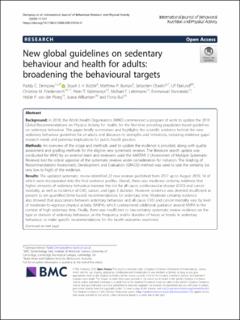| dc.contributor.author | Dempsey, Paddy | |
| dc.contributor.author | Buman, Matthew P. | |
| dc.contributor.author | Chastin, Sebastien | |
| dc.contributor.author | Ekelund, Ulf | |
| dc.contributor.author | Friedenreich, Christine M. | |
| dc.contributor.author | Katzmarzyk, Peter T. | |
| dc.contributor.author | Leitzmann, Michael F. | |
| dc.contributor.author | Stamatakis, Emmanuel | |
| dc.contributor.author | van der Ploeg, Hidde P. | |
| dc.contributor.author | Willumsen, Juana F. | |
| dc.contributor.author | Bull, Fiona | |
| dc.contributor.author | Biddle, Stuart J. H. | |
| dc.date.accessioned | 2021-03-04T13:29:12Z | |
| dc.date.available | 2021-03-04T13:29:12Z | |
| dc.date.created | 2021-01-07T13:09:08Z | |
| dc.date.issued | 2020 | |
| dc.identifier.citation | International Journal of Behavioral Nutrition and Physical Activity. 2020, 17(2020), Artikkel 151. | en_US |
| dc.identifier.issn | 1479-5868 | |
| dc.identifier.uri | https://hdl.handle.net/11250/2731676 | |
| dc.description | This article is licensed under a Creative Commons Attribution 4.0 International License, which permits use, sharing, adaptation, distribution and reproduction in any medium or format, as long as you give appropriate credit to the original author(s) and the source, provide a link to the Creative Commons licence, and indicate if changes were made. The images or other third party material in this article are included in the article's Creative Commons licence, unless indicated otherwise in a credit line to the material. If material is not included in the article's Creative Commons licence and your intended use is not permitted by statutory regulation or exceeds the permitted use, you will need to obtain permission directly from the copyright holder. To view a copy of this licence, visit http://creativecommons.org/licenses/by/4.0/. The Creative Commons Public Domain Dedication waiver (http://creativecommons.org/publicdomain/zero/1.0/) applies to the data made available in this article, unless otherwise stated in a credit line to the data. | en_US |
| dc.description.abstract | Background: In 2018, the World Health Organisation (WHO) commenced a program of work to update the 2010 Global Recommendations on Physical Activity for Health, for the first-time providing population-based guidelines on sedentary behaviour. This paper briefly summarizes and highlights the scientific evidence behind the new sedentary behaviour guidelines for all adults and discusses its strengths and limitations, including evidence gaps/research needs and potential implications for public health practice.
Methods: An overview of the scope and methods used to update the evidence is provided, along with quality assessment and grading methods for the eligible new systematic reviews. The literature search update was conducted for WHO by an external team and reviewers used the AMSTAR 2 (Assessment of Multiple Systematic Reviews) tool for critical appraisal of the systematic reviews under consideration for inclusion. The Grading of Recommendations Assessment, Development and Evaluation (GRADE) method was used to rate the certainty (i.e. very low to high) of the evidence.
Results: The updated systematic review identified 22 new reviews published from 2017 up to August 2019, 14 of which were incorporated into the final evidence profiles. Overall, there was moderate certainty evidence that higher amounts of sedentary behaviour increase the risk for all-cause, cardiovascular disease (CVD) and cancer mortality, as well as incidence of CVD, cancer, and type 2 diabetes. However, evidence was deemed insufficient at present to set quantified (time-based) recommendations for sedentary time. Moderate certainty evidence also showed that associations between sedentary behaviour and all-cause, CVD and cancer mortality vary by level of moderate-to-vigorous physical activity (MVPA), which underpinned additional guidance around MVPA in the context of high sedentary time. Finally, there was insufficient or low-certainty systematic review evidence on the type or domain of sedentary behaviour, or the frequency and/or duration of bouts or breaks in sedentary behaviour, to make specific recommendations for the health outcomes examined.
Conclusions: The WHO 2020 guidelines are based on the latest evidence on sedentary behaviour and health, along with interactions between sedentary behaviour and MVPA, and support implementing public health programmes and policies aimed at increasing MVPA and limiting sedentary behaviour. Important evidence gaps and research opportunities are identified. | en_US |
| dc.language.iso | eng | en_US |
| dc.subject | exercise | en_US |
| dc.subject | physical activity | en_US |
| dc.subject | sedentary | en_US |
| dc.subject | guidelines | en_US |
| dc.subject | public health | en_US |
| dc.subject | global health | en_US |
| dc.subject | chronic disease | en_US |
| dc.subject | cardiovascular | en_US |
| dc.subject | type 2 diabetes | en_US |
| dc.subject | cancer | en_US |
| dc.subject | health promotion | en_US |
| dc.title | New global guidelines on sedentary behaviour and health for adults: Broadening the behavioural targets | en_US |
| dc.type | Peer reviewed | en_US |
| dc.type | Journal article | en_US |
| dc.description.version | publishedVersion | en_US |
| dc.rights.holder | © The Author(s). 2020 | en_US |
| dc.source.pagenumber | 12 | en_US |
| dc.source.volume | 17 | en_US |
| dc.source.journal | International Journal of Behavioral Nutrition and Physical Activity | en_US |
| dc.source.issue | 2020 | en_US |
| dc.identifier.doi | 10.1186/s12966-020-01044-0 | |
| dc.identifier.cristin | 1867049 | |
| dc.description.localcode | Institutt for idrettsmedisinske fag / Department of Sports Medicine | en_US |
| dc.source.articlenumber | 151 | en_US |
| cristin.ispublished | true | |
| cristin.fulltext | original | |
| cristin.qualitycode | 2 | |
